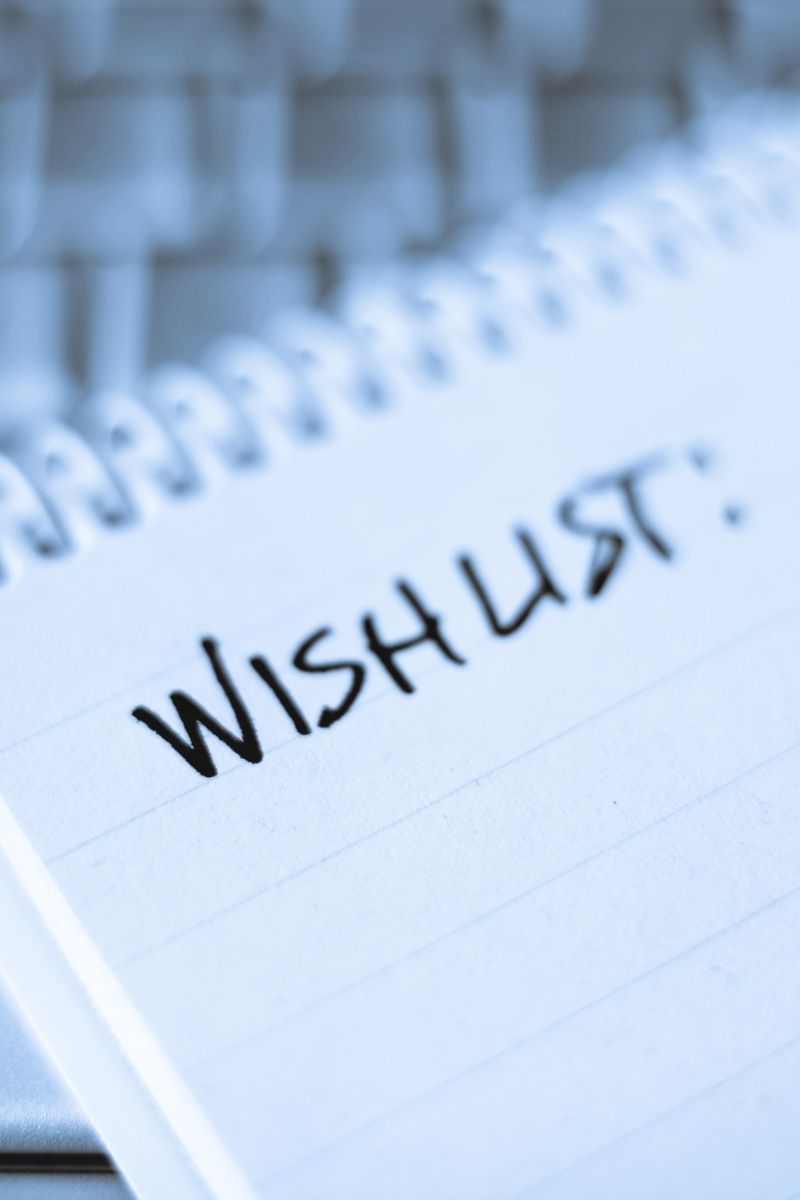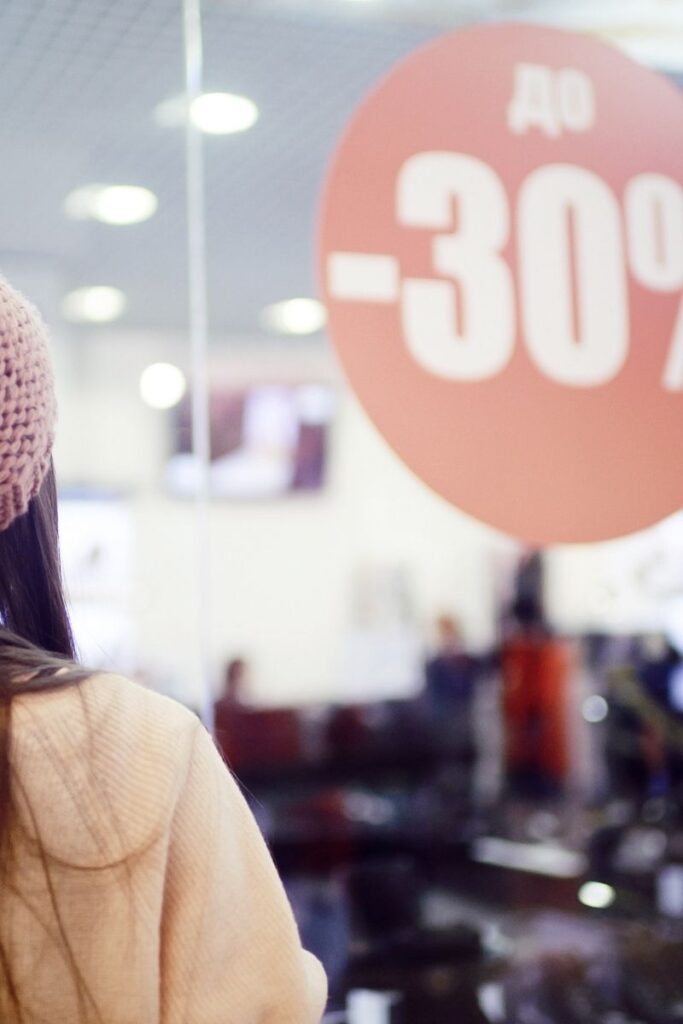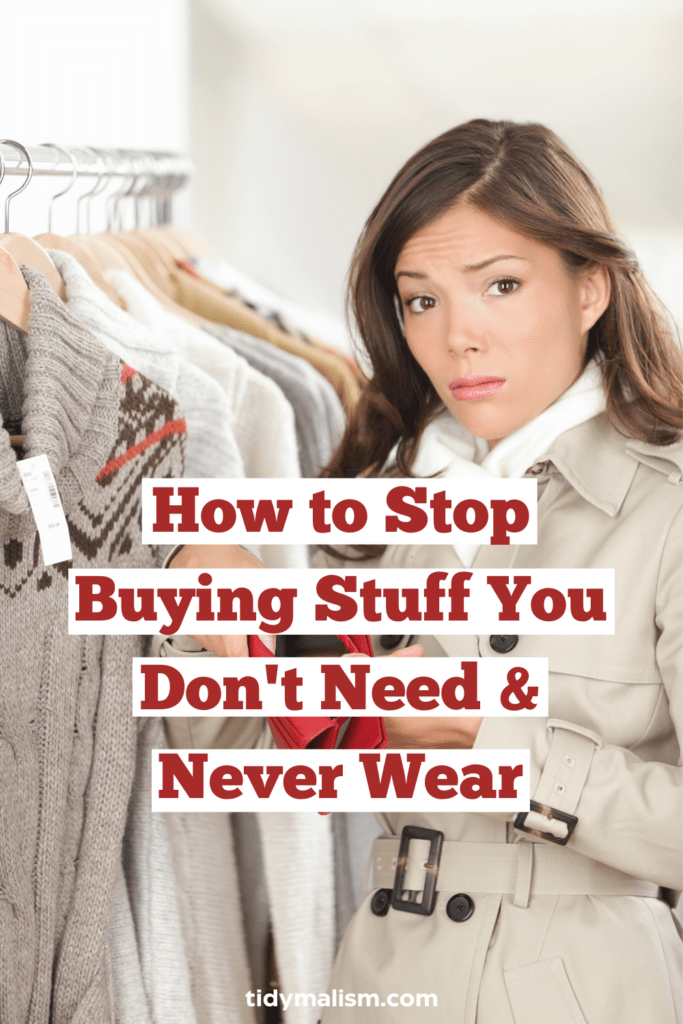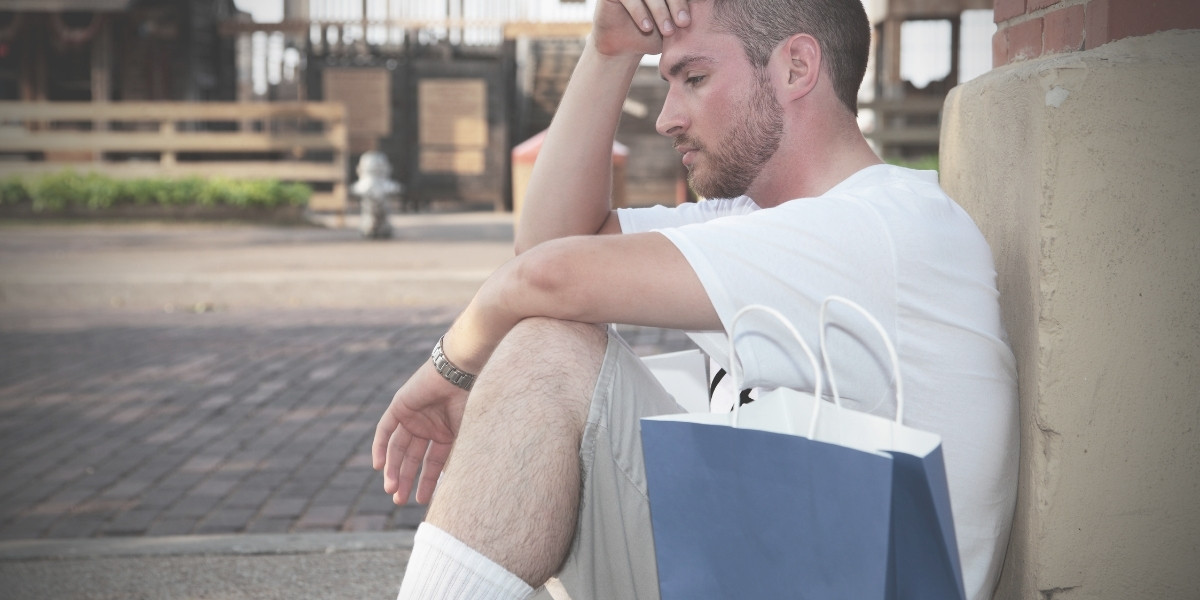Did you ever realise how much stuff you buy winds up in the corner? Forgotten about, broken, or unsightly after one use. Perhaps even entirely unused or unworn. Or so “good” that it’s reserved for a special occasion… which never comes around. That fancy outfit with the tags still on, the expensive designer shoes you only wore once, the fine bone china you’ve never eaten from. It’s a shame, because it’s a waste of money and a waste of space. Why do we keep falling down this shopping rabbit hole, and how can you stop buying stuff you don’t need or wear?
This past year, I decided to do a low-buy challenge to rein in my spending and get a grip on my clutter. Since going low-buy, I’ve come to realise that I no longer actually want a lot of the stuff I previously enjoyed buying. I’ve had some buyer’s remorse along the way as I sorted through my things. Plus, I learnt a lot about what triggered my old shopping habits.
Here’s what my thought process has been like this year, and 10 ways I think you, too, can stop buying stuff you don’t need or never wear. Let’s dig in!
Table of Contents
Understand Your Shopping Triggers
Try This Quick Exercise
Here’s a little brain teaser for you next time you have a few minutes to spare.
Go into your closet, or open a drawer of hobby supplies, or your bathroom cabinet. Now pull out an item or two that you have never used or worn. Maybe it even still has tags on. Answer these questions:
- When did you buy this?
- Where were you when you bought it?
- Do you remember how you were feeling, or why you wanted it?
- Do you know why you’ve never used it or worn it?
Some of my own answers to these questions went like so when I did this exercise with three items:
- Six years ago. On a business trip to Asia. I didn’t know how to spend my free time alone in the evenings so I wandered the shops. I never wore it at home because it’s actually unflattering on me.
- Last year. At home, after the second Corona lockdown had ended. I was excited to hit my favourite department store even though I didn’t need anything. I wanted to buy something, anything really. In all likelihood I was trying to feel alive again. The colour is garish and doesn’t go with anything I own.
- Eighteen years ago. At home browsing eBay. I wanted it because everyone else in my craft group had it and raved about it, so I thought I needed it, too. It’s still in its box because I have no purpose for it.
Can you guess what my purchases were? There were 1) a Japanese-style tunic; 2) a pair of neon yellow leather leggings; 3) a sticker maker. They could have been anything else though. My point is this:
Are we shopping when something else is actually wrong with us? Are we shopping in an effort to fill an emotional void?
Is Shopping Self-Care or Self-Sabotage?
If you begin deciphering what is setting off your consumer urges and depleting your bank account, you will be able to assess and curb your spending in a more strategic manner.
Here are just a few examples of what underlying emotional complexes might be leading you to buy silly things. Ask yourself if you have ever bought stuff when you were suffering from:
- Depression
- Boredom
- Loneliness
- Anger
- FOMO (fear of missing out)
- Denial
- Poor self esteem
- Frustration
Don’t feel bad if you answered yes to any of these. I’ve bought stupid crap in all of the above situations myself. Sometimes I still do. It’s a learning process. What is helpful is to cross-examine yourself next time you’re about to make a purchase.
After all, you can always hold off and buy it later if you decide you really need it. Which brings me to our next tip: keep a wish list, but treat it as a waiting list.
Park Your Wants on a Waiting List If You Want to Stop Buying Stuff You Don’t Need

Wish lists are fun, and they don’t put a dent in your wallet. You can dream big, get decadent, and go downright crazy on your wish list. No one ever has to know.
Then you can go back and cull it as often as you like. Perhaps scratch something off it you no longer want after all.
Treating your curated wish list as a waiting list is key though.
Anytime you’re on the brink of making a non-essential purchase, put it on your wish list.
Then wait.
Come back to it in a few days, a few weeks, or even a few months if it’s an off-season item. Then question your intentions again.
Questions to Ask Yourself Pre-Purchase
Whether it’s shopping online or off, ask yourself these things before making a purchase, and really listen to your gut and inner voice:
- Is this item worth it to me, and to my bank account?
- Will this item make my life better?
- How many hours will I have to work to pay for this item?
- How might this item make me feel bad in the short, mid, or long term?
- Will this item make me a better person?
- Is this item just a pacifier, or instant gratification, because I’m feeling down today?
- What situations will I use this item in? For clothing: can I create at least 3 outfits with this?
- How soon will I use this item if I buy it right now, today?
Wish lists are great because they’re a form of placebo shopping on the one hand, and on the other hand, they serve as helpers in visualising how you will use or wear a particular item.
If you have no vision for the item, don’t buy it. If you have no idea when you’ll wear it, or what with, don’t buy it. And if you’re not going to use it this week or next, don’t buy it. Keep it on your waiting list, or scratch it off entirely later on.
You’ll find that if you keep coming back to certain items you’ve banished to your waiting list for a while, you will grow tired of looking at them and thinking about them. It’s as if you’ve outworn or outgrown the item already, yet you didn’t even have to spend any money on it! It’s an easy way to stop buying stuff you don’t need. Try it out.
Get a New Hobby
Repeat after me: shopping is not a hobby.
If, for example, you’ve determined you have a tendency to shop when you’re bored, it might be high time to develop some new interests outside of consumerism.

How about learning a new language online? Going to a museum instead of the mall? Volunteering at your local elderly community? Signing up for an online career advancement course? Trying out new recipes with exotic ingredients? Becoming a big brother or big sister to a child from a troubled home? Taking up sewing, paper crafts, painting, knitting, or gardening?
There are endless opportunities out there for you, even during a pandemic. You can stop browsing the shops if you fill that void with something new to occupy your mind and your free time.
Consider Upkeep Costs
Another way to stop buying stuff you don’t need is to consider how much it will cost you to maintain it. That’s right: the cost of an item doesn’t end when you’ve paid for it.
Having more stuff equates to more stress in your life. For every larger purchase you make, you need to factor in the cost of insurance, repairs, spare parts, and general upkeep. Plus the time it takes to track all the stuff in your home inventory.
Not to mention the amount of space it takes up. Space that you’re paying for.
Even if it’s not a big-spend purchase, keep in mind that little things add up, too, in terms of household insurance and space. Do you really want to be paying extra premium for junk that’s piled up in your home inventory?
Declutter
If you’ve been following me for any length of time, you know I love decluttering! It’s a great starting point for so many problems. Whether you’re depressed or anxious, need to downsize or start planning your estate, or are just trying to make everything fit into a small kitchen or tiny bathroom that lacks storage space, decluttering is the way to go, and it can also help you to stop buying stuff you don’t need.
By sorting and culling what you already own, you’ll gain a better overview of your situation and maybe even find stuff you had forgotten about. Getting rid of things you no longer like or use will free up space for the stuff you do love.
If you’re not sure where to start decluttering, check out these ten things you can easily declutter today, download my super simple, free PDF checklist to kickstart a decluttering project, or try doing a 30-day declutter challenge.
You might also like my article about what to do with all the stuff you’ve decluttered. It can be super overwhelming when you’ve sorted out a mountain of items around the house and then don’t know how to get it all out of the way. I’ve got you covered and walk you through all your options in that post.
Digital Decluttering
Decluttering with the intent to stop buying stuff you don’t need or wear also means decluttering digitally. Once you’re determined to turn your consumer habits around and start buying less, it’s time to unsubscribe from all those marketing emails that clutter up your inbox.
It also makes sense to evaluate who you follow on social media. Watching haul videos on YouTube and constantly being bombarded with the products influencers peddle on Instagram can sabotage even the best efforts to consume less.
So avoid the seduction of social media. Unfollow the folks who bombard you with temptation. Follow like-minded people instead. There’s a lot of great content out there around intentional living, minimalism, frugal personal finance, and sustainability. Tuning into that instead can help cement your new goal to stop buying crap.
Stop Aimlessly Browsing the Sales
Staying clear of temptation is key if you want to clamp down on your spending and stop buying stuff you don’t need. If you buy something simply because it’s on sale, you’ve fallen prey to marketers’ sales culture which cultivates a fear of missing out.

Sales are always on nowadays. They used to be special occasions at certain times throughout the year, but nowadays you can trust that there’s always a sale going on somewhere.
You can quit participating in the sales culture with ease by unsubscribing to retailers’ marketing emails and staying out of the shops unless you actually need something specific.
Staying away from sales will really help you avoid impulse purchases. It’s definitely helped me tremendously this year on my low-buy journey towards more minimalism.
There is one exception to staying clear of sales though. If you’ve had a certain wish list item parked on your waiting list for a while and it finally goes on sale, that’s a great time to do a final assessment of whether you really still want it. If you do, get it at the discounted price.
Generally speaking, just about everything goes on sale at some point, and it’s unwise to pay full price when you can wait a bit for a reduction.
Repair & Mend What You Have
The more you cull and declutter your belongings, the greater the chance is that you’ll only have things you really love. Take care of those things. Bring shoes and boots to the cobbler if the soles need replacing. Mend that tiny hole in your good cashmere sweater, or ask your local seamstress to do it. Have your old blender fixed instead of buying a new one.
Using things until they fall apart will not only save you money, but it’s a more environmentally friendly way of living. And the longer you’re able to maximise the lifespan of your items and enjoy them, the easier it becomes to stop buying stuff you don’t need.
Keep a Diary of Purchases
If you have a particular weak spot when it comes to blowing money, keeping track of your purchases in that area can be a huge help.

I know my own weakness is in the clothing and accessories area, so I track all of the purchases I make there in minute detail. This helps me assess impulse purchases, and it keeps me accountable. By keeping a diary of what you bought, you can really scrutinise what you’ve introduced to your household or wardrobe.
Was it worth it? Are you still using it? Wearing it? Has it made you feel like a better person, made your life easier, or made you feel prettier, smarter, calmer, etc.?
Asking yourself these questions post-purchase will make you a smarter consumer in the run-up to any future purchases.
Use the tool of your choice to track your weak spot purchases. A simple little notebook (I’m a huge fan of the mini cahiers from Moleskin), a spreadsheet, or a dedicated note in a note-taking app like Devonthink will do the trick.
Buy Less, But Better
You’ve heard of the maxims “less is more” and “quality over quantity.” Both bear a lot of truth, and adopting this mindset is also better for the environment. Fast fashion and cheap manufacturing are killing our planet.
Even if you’re not into the whole sustainability trend, the bitter truth is that making cheap purchases actually costs you more money.
Think of all the $5 t-shirts from H&M, Zara, or Primark you’ve had in the past. They looked ready for the bin after their first or second wash, didn’t they? Compare them to the $29 tee you got on sale at Nordstrom’s five years ago and still wear. Isn’t that a huge difference in quality? Your cost per wear for the expensive shirt was pennies. By comparison, your cost per wear for the cheap tee was likely $5. 🤯
As with everything, there are some exceptions to the buy less, buy better guideline. Purchasing super expensive designer goods that get little to no use, for example, won’t get you any bang for your buck. And sometimes you really do need an item for exactly just one use, and you can’t rent or borrow it. In cases like that, it can make sense to go with your most inexpensive option.
Make Purchases For the Life You Live Now
I still struggle with this one myself, and in my particular case, it has definitely correlated to sales culture in the past. Oftentimes I would purchase something I thought was fabulous because it was on sale and I envisioned myself needing it at some point down the road.
Stupid mistake.
If you don’t already ski, you don’t need to buy skiing gear just because it’s on sale and you think your in-laws might invite you to their lodge in the Alps next winter.
If you don’t have a ball to go to anytime soon, you do not need to buy the evening gown just because it’s on sale and you think you will have a gala event to attend again some day, at some point.
And if you hate working out, you’re still going to hate working out even if you splurge on Lulu-Lemon workout outfits.
Only buy things that suit your life and your lifestyle right now. Not for the fantasy life of some future version of yourself.
Finally, be ruthless! When you bring new things home, leave them in plain sight and keep the tags on. If you have not used them or worn them within one week of purchasing, return them to the store or online shop.

I had fun writing this post and would love to know how it resonated with you. Have you considered curbing your spending habits at all? Or have you done so already? Please leave a comment and let us know how you managed to stop buying stuff you don’t need or wear!





Leave a Reply